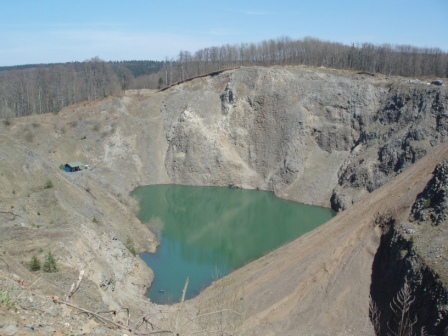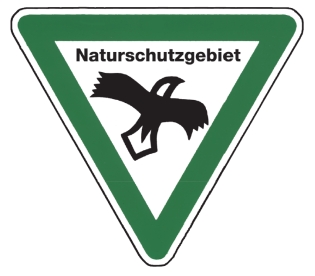Steinbruch Schwarze Berge mit Basaltsee EarthCache
Steinbruch Schwarze Berge mit Basaltsee
-
Difficulty:
-

-
Terrain:
-

Size:  (not chosen)
(not chosen)
Please note Use of geocaching.com services is subject to the terms and conditions
in our disclaimer.
Hier hat man einen schönen Einblick in einen Basalt Steinbruch
mit einem kleinen Basalt See.

Basalt:
Basalte sind vulkanische Gesteine.
Sie sind meist dunkel oder schwarz und bestehen überwiegend aus
Plagioklas und dunklen Mineralen. Wegen ihres Reichtums an
Mineralen, die Eisen und Magnesium enthalten, bezeichnet man
Gesteine aus der Basaltfamilie auch als "mafische Gesteine"
oder
auch als "basisch" (bezogen auf den geringen Quarzgehalt).
Kühlt ein Magma mit basaltischer Zusammensetzung langsam ab,
entsteht meist ein Gabbro.
"Basalt" ist der Name für eine ganze Gesteinsgruppe, die in sich
mehrere, zum Teil sehr unterschiedlich zusammengesetzte
Gesteine vereint.
Basalte werden nach ihrer chemischen Zusammensetzung oder nach dem
geologischen Rahmen, in dem sie auftreten, klassifiziert.
Kriterien für diese Unterscheidungen sind zum Beispiel der Gehalt
an Feldspatvertretern (Foide) oder der Olivinanteil.
Basaltmagmen entstammen dem oberen Erdmantel und stellen
Teilschmelzen des dort vorhandenen Gesteins (Peridotit) dar.
Basaltische Magmen sind wegen des geringen Quarzgehaltes sehr
beweglich - gelegentlich fast so dünnflüssig wie Wasser.
Daher können sie schnell aufsteigen. Manchmal werden dabei
Fragmente des Peridotits aus großer Tiefe mitgerissen.
Wir finden sie als Olivinklumpen im Gestein.
Wie alle Vulkanite kühlt der Basalt an der Erdoberfläche sehr
schnell ab und hat deswegen ein dichtes Gefüge.
Manchmal finden sich Einsprenglinge, also Kristalle, die bereits
vor dem Austritt der Lava gebildet wurden.
Dunkle Einsprenglinge sind oft Augit, gelegentlich kommen auch
Amphibole vor.
Helle, meist längliche Kristalle im Basalt sind in der Regel
Plagioklase.
Solche Gesteine, in denen eine erkennbare Kristallbildung begonnen
hat, werden in Skandinavien als "Diabas" bezeichnet.
Nach der heute gültigen Klassifizierung werden diese Gesteine
"Dolerit" genannt.
Die Grenze zwischen "Basalt" und " Diabas (Dolerit)" ist
unscharf.
Um diesen Earthcache zu loggen, schickt mir per Email die
Antworten auf folgende Fragen.Ich würde mich freuen wenn ihr ein
Bild von euch und
eurem GPS vor der Nordost Wand zu den obenstehenden Koordinaten zu
eurem Log hochladen würdet.!
1. Beschreibe die Farbe der Nordostwand.
2.Wie ist der schwarze Basalt enstanden.
Wartet bitte nach der Email auf die Logfreigabe!
Logs ohne Freigabe werden kommentarlos gelöscht!
Logs, die die Antworten auf oben gestellte Fragen beinhalten werden
auch gelöscht!
Bitte nur an die Stelle gehen wo gemessen hab.
Der Steinbruch muß zum lösen des Cache nicht betreten werden.
!!!!

Du befindest dich in einem Naturschutzgebiet. Verhalte dich
dementsprechend!
Stelle dein Fahrzeug nur auf den ausgewiesenen Parkplatz
ab.
English:
At this place you have a nice view into a basalt quarry with a
small basalt sea.
Basalt:
Basalts are volcanic rocks.
Usually they are dark or black and consist mainly of plagioclase
and dark minerals. Because of their wealth
Minerals, iron and magnesium, is known from rocks of the basalt
family as "mafic rocks" or
as "basic" (based on the low quartz content).
Cools a magma of basaltic composition with a slow, usually results
in a gabbro.
"Basalt" is the name for a whole rock group that in several,
sometimes very different compositions
United rocks.
Basalts are classified according to their chemical composition or
the geological setting in which they occur.
Criteria for these distinctions are, for example, the content of
feldspathoids (FOID) or Olivinanteil.
Basaltmagmen come from the upper mantle and partial melting of the
present there are rocks (peridotite) dar.
Basaltic magmas are due to the low quartz content very mobile -
sometimes almost as thin as water.<<br /> Therefore, they
can rise quickly. Sometimes fragments of this peridotite is dragged
from a great depth
We find them as Olivinklumpen in the rock.
Like all volcanic rocks of the basalt on the surface cools very
rapidly and therefore has a dense structure.
Sometimes there are inclusions, so crystals that were formed before
the exit of the lava.
Dark inclusions are often augite, amphibole occasionally
occur.
Light, mostly elongate in the basalt are usually plagioclase.
Such rocks, has begun in which a detectable crystal formation, are
referred to in Scandinavia as "diabase".
According to the currently valid classification, these rocks
"dolerite called.
The boundary between "basalt" and "diabase (dolerite)" is
blurred.
To log this cache, send me an email to Answers to the following
Fragen.Ich would love it if you a picture of you
your GPS off the northeast wall to the above coordinates to would
you upload your log.
1st Describe the color of the northeast wall.
2.How is the imagery was black basalt.
please wait for the email to log release
Logs without a release will be deleted!
Logs, which will include the answers to questions posed above also
deleted!
Please just go to the place where've measured.
The quarry has not solved the cache to be accessed. !!
too!
Pleace notice that you are in a natural protected area.
Place your vehicle only on the designated parking
area.
Additional Hints
(No hints available.)